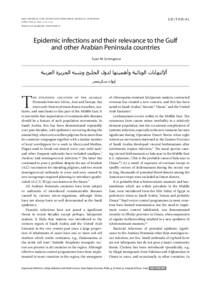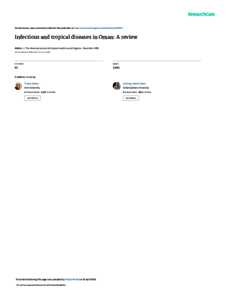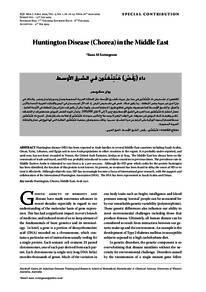Document
Epidemic infections and their relevance to the Gulf and other Arabian Peninsula countries.
Other titles
الإلتهابات الوبائية وأهميتها لدول الخليج وشبه الجزيرة العربية
Publisher
College of Medicine, Sultan Qaboos University.
Gregorian
2003-04
Language
English
English abstract
The strategic location of the arabian Peninsula between Africa, Asia and Europe, has since early historical times drawn travellers, seafarers, and merchants to this part of the Middle East. It is inevitable that importation of communicable diseases should be a feature of such population movements. In Saudi Arabia, this has been demonstrated repeatedly over past decades, with epidemics occurring during the annual Hajj, when over a million pilgrims from more than 80 countries congregate together with a similar number of local worshippers for a week in Mecca and Medina. Plague used to break out almost every year until 98,1 and other frequent outbreaks have included smallpox,2 cholera,3 and meningococcal infection.3,4 The latter has continued to pose a problem despite the use of bivalent (A,C) vaccination for intending pilgrims, and two recent meningococcal outbreaks in 2000 and 200 caused by new serogroups required planning to introduce quadrivalent (A,C,Y, W135) vaccination in the future.5 All Arabian Peninsula countries have been subject to outbreaks of introduced communicable diseases caused by various micro-organisms, although these have not always been so well documented as the Saudi epidemics.
Member of
Resource URL
Citation
Scrimgeour, Euan M. (2003). Epidemic Infections and their Relevance to the Gulf and other Arabian Peninsula Countries. Sultan Qaboos University Medical Journal, 5 (1–4.
Arabic abstract
جذب الموقع الاستراتيجي لشبه الجزيرة العربية بين إفريقيا وآسيا وأوروبا ، منذ العصور التاريخية المبكرة ، المسافرين والبحارة والتجار إلى هذا الجزء من الشرق الأوسط. من المحتم أن يكون استيراد الأمراض المعدية سمة من سمات تحركات السكان هذه. في المملكة العربية السعودية ، ظهر هذا مرارًا وتكرارًا على مدار العقود الماضية ، مع حدوث أوبئة خلال موسم الحج السنوي ، عندما يتجمع أكثر من مليون حاج من أكثر من 80 دولة مع عدد مماثل من المصلين المحليين لمدة أسبوع في مكة والمدينة. اعتاد الطاعون أن يندلع كل عام تقريبًا حتى 9-8،1 وقد اشتملت الفاشيات المتكررة الأخرى على الجدري ، 2 الكوليرا ، 3 وعدوى المكورات السحائية. ج) التطعيم للحجاج الراغبين ، وفاشيتي المكورات السحائية مؤخرًا في عام 2000 و 200 درجة مئوية بسبب المجموعات المصلية الجديدة التي تطلبت التخطيط لإدخال التطعيم الرباعي (A ، C ، Y ، W135) في المستقبل 5. من الأمراض المعدية المدخلة التي تسببها الكائنات الحية الدقيقة المختلفة ، على الرغم من أن هذه لم يتم توثيقها دائمًا بشكل جيد مثل الأوبئة السعودية.
Category
Journal articles



